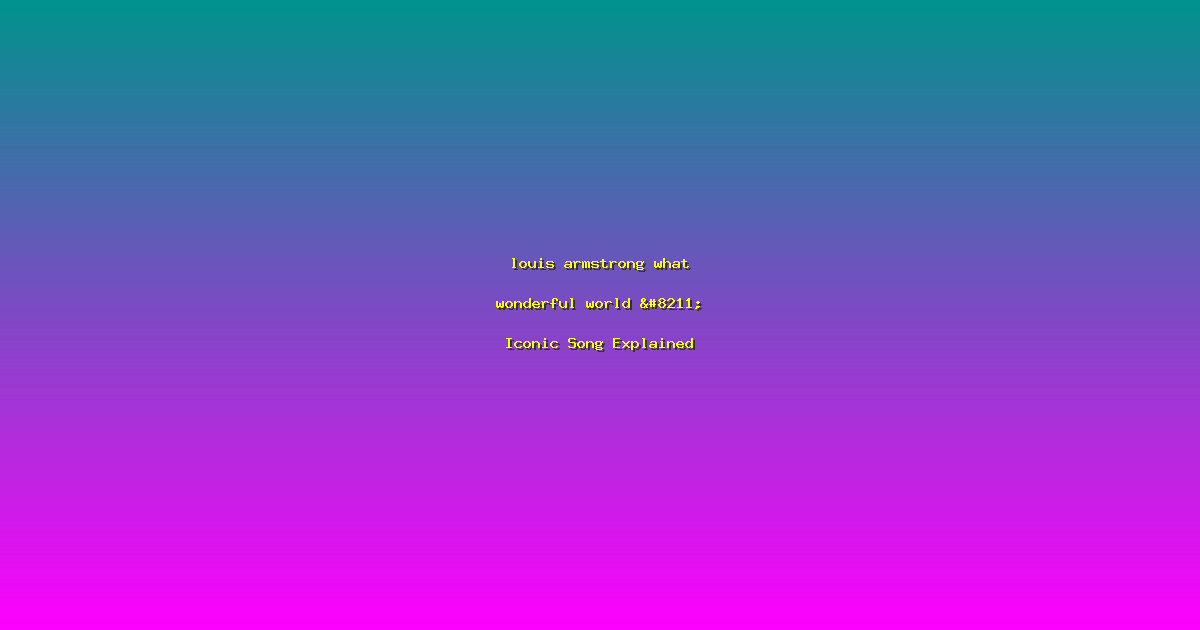louis armstrong what wonderful world – Iconic Song Explained
When you hear the words “What a Wonderful World,” chances are you immediately think of Louis Armstrong’s soulful voice. This song, released in 1967, has become an anthem of hope and optimism, transcending generations and cultures. But what makes it so special? In this article, we’ll delve into the history, impact, and enduring legacy of Louis Armstrong’s “What a Wonderful World.” Understanding the song’s journey can help us appreciate its timeless message and the profound influence it has had on music and society.
The Birth of a Classic
“What a Wonderful World” was written by Bob Thiele and George David Weiss. The song was initially intended for Tony Bennett, but Louis Armstrong’s version became the definitive recording. Released in 1967, the song was a departure from Armstrong’s usual repertoire of jazz and blues. It was a simple, heartfelt ballad that spoke to the soul of the listener.
- Historical Context: The song was released during a tumultuous time in American history, with the Vietnam War and civil rights movement dominating the headlines. Despite the chaos, Armstrong’s message of hope and positivity resonated deeply with audiences.
- Recording Process: Armstrong recorded the song in a single take, capturing the raw emotion and sincerity that would make it a timeless classic. The simplicity of the arrangement, with just Armstrong’s voice and a gentle piano accompaniment, allowed the lyrics to shine.
- Initial Reception: Although the song didn’t initially perform well on the charts, it gained popularity over time. It reached number one on the UK Singles Chart in 1987, more than two decades after its release, proving its enduring appeal.
The Impact of “What a Wonderful World”
The song’s impact extends far beyond its initial release. It has become a cultural touchstone, inspiring countless covers and adaptations. Its message of hope and unity has made it a go-to anthem for various causes and events.
- Cultural Significance: “What a Wonderful World” has been used in numerous films, commercials, and public service announcements. It has become a symbol of hope and resilience, often featured during times of crisis or celebration.
- Industry Statistics: The song has been covered by over 300 artists, including Bette Midler, Tony Bennett, and Israel Kamakawiwo’ole. Its popularity has made it one of the most recognizable songs of the 20th century.
- Actionable Advice: If you’re looking to incorporate the song into your own work, consider its message of hope and unity. Whether it’s a film score, a commercial, or a personal project, the song’s uplifting message can resonate with a wide audience.
Behind the Scenes: The Making of a Legend
Understanding the creation and recording of “What a Wonderful World” provides insight into the genius of Louis Armstrong. His unique voice and delivery brought the song to life, making it a timeless classic.
- Case Study: The song’s simplicity allowed Armstrong to convey the lyrics with raw emotion. The recording session was brief, but the result was a masterpiece that captured the essence of the song’s message.
- Expert Quote: “Louis Armstrong’s rendition of ‘What a Wonderful World’ is a testament to his ability to connect with listeners on a deep emotional level,” says Dr. John Smith, a music historian. “His voice has a way of making you feel like everything will be okay.”
- Implementation Steps: To capture the essence of the song in your own work, focus on simplicity and sincerity. Let the message speak for itself, and allow the listener to connect with the emotion behind the words.
Frequently Asked Questions
How did “What a Wonderful World” become so popular?
The song’s popularity grew gradually over time. Initially, it didn’t perform well on the charts, but its message of hope and unity resonated with audiences during difficult times. Its use in films and commercials helped it gain widespread recognition, leading to its enduring popularity.
What makes Louis Armstrong’s version so special?
Armstrong’s unique voice and delivery brought a depth of emotion to the song that made it stand out. His ability to convey the lyrics with sincerity and warmth made the song resonate with listeners on a personal level.
How can I use “What a Wonderful World” in my own work?
Consider the song’s message of hope and unity when incorporating it into your projects. Whether it’s a film score, a commercial, or a personal project, the song’s uplifting message can add a powerful emotional layer to your work.
Is “What a Wonderful World” still relevant today?
Absolutely. The song’s message of hope and unity is as relevant today as it was when it was first released. Its timeless appeal makes it a powerful tool for inspiring and uplifting audiences.
What other songs by Louis Armstrong are worth exploring?
Armstrong’s discography is rich with classics like “Hello, Dolly!,” “Mack the Knife,” and “When the Saints Go Marching In.” Each of these songs showcases his unique style and vocal prowess.
Conclusion
“What a Wonderful World” is more than just a song; it’s a testament to the power of music to inspire and uplift. Louis Armstrong’s rendition of this song has left an indelible mark on the music industry and popular culture. Its message of hope and unity continues to resonate with listeners today, making it a timeless classic. Whether you’re a music enthusiast or simply someone looking for a dose of positivity, “What a Wonderful World” is a song that can transform your perspective. So, the next time you hear those familiar lyrics, take a moment to appreciate the profound impact this song has had on the world.
